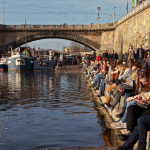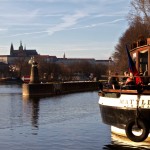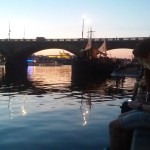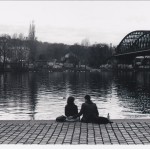In the summer evenings, often even just walking along the Vltava may become difficult due to the high density of people standing still, sipping a beer and chatting a few centimeters from the river
There are cities that change in appearance more than others, from season to season. There are those, for example, where the climate difference between one time of year, and another is such that suggests to their inhabitants to change their habits, the places they frequent, and often even the very areas they live in. So affluent areas of life and activity during a certain period, are rarely visited and inactive in another, with a cyclic alternation of citizen movements in the year, as if to mark a kind of real alternating rhythm of the breath of city. Prague is surely among them, and if the image of the Czech capital in the winter and autumn is related to the intense life in its breweries and local cafés, in the spring and summer, things change, and the protagonists of the free time of Prague become the many wonderful city parks, and other open spaces that Prague offers, including one in particular, which especially in recent years, has become a favorite place in the hot season for many citizens and tourists: the banks of the Vltava.
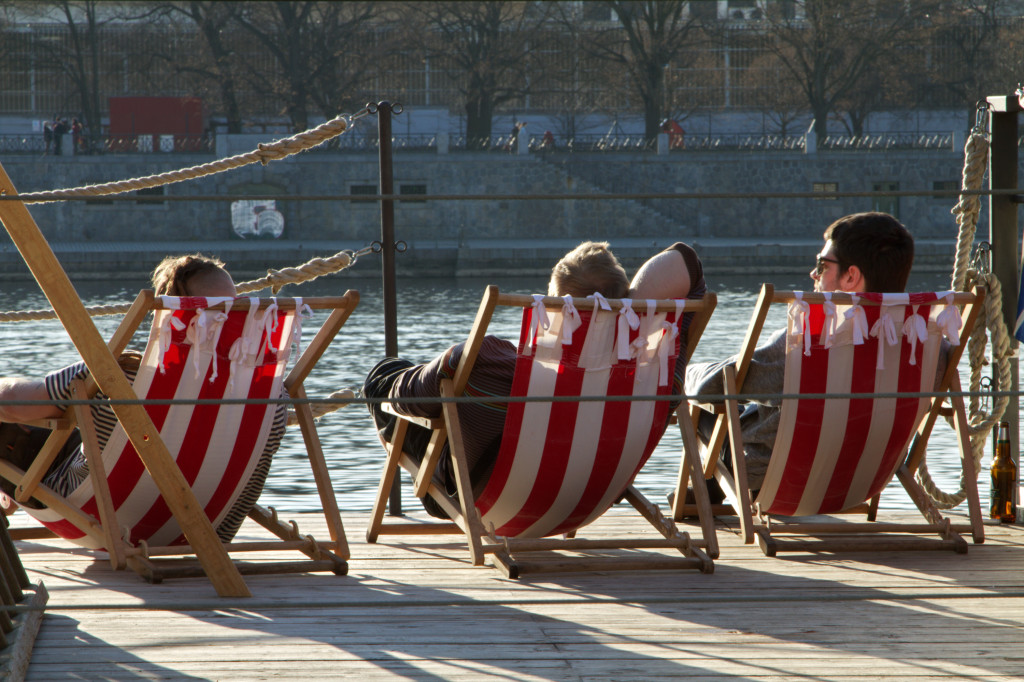 In its route through the city, which bisects the Czech capital, the symbol of the country river, whose waters have been celebrated by poets and national artists, offers evocative and varying views, which together with the monuments and other attractions, make Prague one of the most beautiful and visited cities in the world.
In its route through the city, which bisects the Czech capital, the symbol of the country river, whose waters have been celebrated by poets and national artists, offers evocative and varying views, which together with the monuments and other attractions, make Prague one of the most beautiful and visited cities in the world.
Náplavka, the part of the riverside that from Výstavní síň Mánes lightly touches the waters of the Vltava and extends first to Masarykovo nábřeží and then to Rašínovo nábřeží almost under the old Vyšehrad fortress, is perhaps the clearest example of the growth and improvement of the city in recent years, but also of how the tastes and habits of its people are changing.
This stretch of the bank, a little less than a kilometer and a half long, until seven or eight years ago, despite being in the centre of Prague, still bore the effects of urban decay that the times of real socialism had bequeathed on the city. The abandoned deposits by large rusty shutters under the roadside, some rejection here and there and a few empty barges docked to the berths, were certainly not a pleasant background for citizens desiring the sun’s rays in the Sunday walks on the riverfront, and too close to the stream, with the danger of floods, for years didn’t attract the Czech investors to improve the place, as occurred in other areas and districts of Prague.
Things however, really changed and in a big way, paradoxically, after the great flood that hit Prague in 2002, and wreaked major damage to the city. Already a few years after the dramatic event, following a hunch subsequently proved to be right, someone began to take a serious interest in Náplavka. The restaurant “Vltava”, a unique and historic inn on the spot, was rebuilt and renovated, and shortly afterwards other more or less improvised small bars started to arise, which offered beer and other drinks to the riverfront goers, leading it to slowly emerge from the condition of degradation.
Over the years, the bars have multiplied and old docked barges have become floating restaurants and bars where you can drink and eat the typical Czech dishes to accompany the beer. Families with children on sunny weekends have returned, and the city regained a vital area of great importance for its development. What made a strong contribution to the rebirth of the area and to the economic development of it were, as of 2010, the Farmářské trhy, the now famous agri-food markets of the city, born from the examples of cities like London and New York, where you can find Czech quality products, that from the month of March, every Saturday morning, attract thousands of people on the banks of the river and have even been reviewed and recommended by TripAdvisor. Year after year the stalls of vendors have increased and today the market has soared. In addition to classic typical products of Czech farmers you can find cakes, all kinds of drinks and high quality street food, including live music and smells reminiscent of the typical village festivals and typical markets in many other European capitals.
But that’s not all. In the last 3-4 years, Náplavka has made an important leap, and from a regained city leisure area, it has transformed into a real trendy place that attracts in the beautiful summer season, at all hours of the day and late into the night, with hundreds of young people, on foot or by bicycle, crowding the banks of the river and attending the new “trendy” bars which often improvised, display some characteristics attributable to the typical style of the underground “hipster” subculture, but not only to them, and gave new impetus to the area. From a barbecue boat with friends on the river, to a drink on one of the many boats docked there, the choice is really wide. On summer evenings, there is often live music and even walking becomes difficult due to the high density of people still sipping a beer and chatting a few centimeters from the river, in an atmosphere reminiscent of similar realities of other river towns like the area of Trastevere in Rome, Berlin along the Spree, or the typical Amsterdam canals.
An entire series of varying events: cultural, sporting, economic, if you prefer, are now organized in Náplavka, from the “Prague Boat Show” to small fairs, from concerts to art exhibitions, the choice varies. Yet, what was of benefit to the situation was also the other side of the river, until a couple of years ago, still in a state of advanced decay, namely Náplavka Smíchov, in the district of Prague 5. Close to the Smíchovská pláž, there are often organized markets selling clothes and jewelry crafts, a small festival of street food, second-hand items and markets, and every summer there are open-air movie nights. The banks have already been partly cleared, and what was not done to improve the area, will certainly be done shortly, given the interesting opportunities for economic development at stake.
Even the parallel streets overlying the riverfront, especially Rašínovo nábřeží and those immediately adjacent, were affected positively by the Náplavka transformation. Restaurants, ice cream shops, ateliers and cafes have opened doors attracting more and more visitors and people interested in renting or buying homes in the area that has unsurprisingly witnessed a significant increase in their prices in recent years to the benefit of the owners of property, of course, but also the city in general, offering an urban space, to further improve the quality of life of its citizens.
by Mauro Ruggiero





